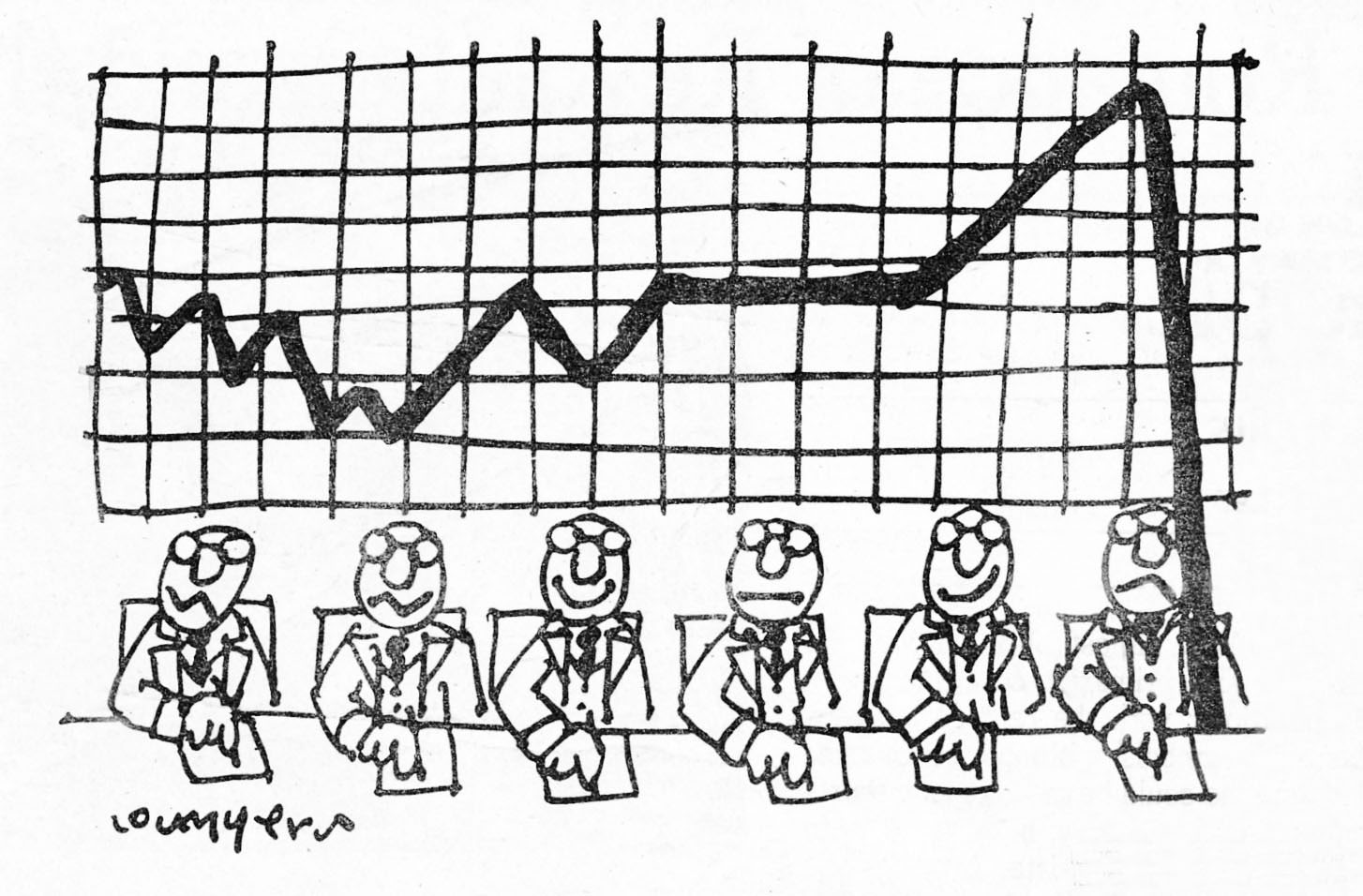
Rooting for Money
GREED AND GLORY ON WALL STREET
The Fall of The House of Lehman
By Ken Auletta
Random House. 253 pp. $19.95
THERE IS plenty of greed, but not much glory, in Ken Auletta’s intricate account of the decline and fall of Lehman Brothers. Until it was auctioned off to American Express in 1984, Lehman Brothers was Wall Street’s oldest continuing partnership, and arguably the nation’s premier investment banking firm.
In the old days — some would say the good old days — the Lehman Brothers name was regarded, even by the firm’s competitors, with a special kind of reverence. “The partners at Lehman were all men of stature,” Felix Rohatyn of Lazard Freres tells Auletta. “They were principals. You dealt with them as owners of a great house. You felt that if there was any such thing as a business aristocracy, and at the same time a highly profitable venture, that was it.”
This book masterfully documents how greed — greed for power, greed for money — came to fracture the foundations of a firm whose roots in American finance stretched back to 1850. It is the story of how Lehman’s partners engineered, in effect, a run on their own bank.
The disorder in the House of Lehman began in 1969 with the death of Robert (Bobbie) Lehman, a descendant of the firm’s founders. In Bobbie Lehman’s world, “deal” was a tainted word, and partners were forbidden from using it in connection with underwritings and mergers. He ruled the firm with an iron hand, but the hand held a sterling-silver spoon. “At Lehman,” he liked to say, “we go first class.”
After Bobbie Lehman’s death, profits gradually came to matter more than people. His successor as chairman, Frederick Ehrman, dressed down partners at meetings by barking, “That’s the stupidest idea I ever heard of.” Ehrman eventually was fired, more or less, and replaced by Peter G. Peterson, who had been secretary of commerce in the Nixon administration before joining Lehman Brothers in 1973.
Peterson’s vision was to build Lehman Brothers into a full-service Wall Street firm. Even though some partners opposed the idea, Peterson’s biggest management problem proved to be his own personality. Many Lehman principals found him to be aloof, arrogant, even condescending. One of them was Lewis L. Glucksman, who had transformed Lehman’s trading operations into a money machine, and whom Peterson chose to introduce, on more than one occasion, as “my fat friend Lew.” In 1983, Glucksman gambled on a coup, and won.
When Lehman Brothers started bleeding red ink soon after that, Glucksman outraged partners with his seat-of-the-pants management decisions, the last of which was trying to slice the firm’s $30,000-a-year cigar bill by one-third. Some likened Glucksman after that episode to Captain Queeg. And, as the drain on the firm’s capital continued, many Lehman partners began thinking about what once would have been unthinkable: “cashing out,” and the sooner the better.
The Lehman partners pressured a reluctant Glucksman into complying, and, in May 1984, the last deal was done. American Express agreed to pay $380 million for the House of Lehman. By Auletta’s reckoning, Peterson got $23 million for his share of the firm, Glucksman got $15.6 million for his, and so on down the line.
Auletta brings an admirable degree of richness and realism to this story, and even those who read his two-part version of it in The New York Times Magazine last year will find Greed and Glory on Wall Street no less riveting. Auletta secured the cooperation of both Peterson and Glucksman, interviewed more than half of the firm’s 77 partners, and was given access to important internal documents. The most revealing of them is a 101-page report that was drawn up by Lehman partners soon after Peterson became chairman. The report concluded, among other things, that Lehman Brothers’ major weaknesses included “the lack of a carefully designed business strategy” and “a fragmented and undiscplined approach to running a business.”
So maybe greed within Lehman Brothers was only the half of it. Incompetence, it seems, was the other half.
THE YEAR THEY SOLD WALL STREET
By Tim Carrington
Houghton Mifflin. 245 pp. $16.95
SOMETHING went wrong on Wall Street a few years back, when old-line, independent securities houses seemed to suddenly become something of an endangered species in the financial world. Some of the biggest fish in the Fortune 500 — American Express, Prudential Insurance, and Sears Roebuck, for example — saw new profits in bringing Wall Street to Main Street, and apparently figured that swallowing up smaller fish was the easiest way of doing it.
Tim Carrington, a first-rate reporter for The Wall Street Journal, has produced a superb account of how all this came to pass. In The Year They Sold Wall Street, Carrington follows one deal — the acquisition of Shearson Loeb Rhodes by American Express — from conception to completion, zeroing in on the three men who made it happen. First there is Sandy Lewis, the Wall Street renegade who came to view the merger as a way to rescue his reputation as a brilliant deal-maker. Lewis brought together Sandy Weill, the street-smart wheeler-and-dealer behind the tremendous expansion of Shearson Loeb Rhodes, and James D. Robinson II, the genteel Southerner who had helped build American Express into one of the world’s financial powerhouses. Lewis, the matchmaker, employed a simple strategy: He seemed not to know the meaning of the word “no.”
But Carrington’s book is much more than the anatomy of this mega-deal. He skillfully weaves in the kind of history and context that bring a bigger picture into focus: the transformation of Wall Street, once the home of carriage-trade investment bankers, into a battleground for America’s corporate giants.
TRADING
Inside the World’s Leading Stock Exchanges
By Susan Goldenberg
Harcourt Brace Jovanovich. 288 pp. $22.95
THIS BOOK has everything a reader might want to know about more than a dozen stock, commodity and option exchanges —everything, and then some. Susan Goldenberg, a Canadian financial writer, has ably compiled what amounts to a business- minded Baedeker for stock-exchange junkies everywhere.
Here are the behind-the-scenes stories not only of the Big Board, but little boards in the United States and their foreign counterparts, from Amsterdam to Zurich. The publisher bills Trading as “fascinating and informative reading,” but that is only partly true. It is informative reading.
Where else, for example, might we learn how commodity traders are viewed by the president of a Chicago company that designs furniture and fixtures for trading floors? (“They’re animals,” he says. “They destroy anything. They have no sense of the value of materials.”) Or a long-running gag in German financial circles? (“How do you make a small fortune? By investing a large one in the stock market.”)
Even those with less than a passing interest in stock exchanges may find this book worth reading for its engaging illustrations of the world’s disparate cultures of finance. As for the exchanges themselves, Goldenberg perceptively analyzes, though perhaps with too fine an eye for detail, the financial forces that make them tick. As competition has grown fiercer, the exchanges have introduced a dizzying array of new products (options on futures, for instance) and invested in sophisticated electronic gadgetry to move them. Not so, however, in Switzerland, where an official of the Geneva Stock Exchange makes the case that new is not necessarily improved by citing the continued popularity of “open outcry” — shouting — at fish and vegetable markets.
But the future of the financial world marches on outside of Switzerland, and Trading is a good, long look at the shape of things to come.
HOW TO READ THE FINANCIAL PAGES
By Peter Passell
Warner. 144 pp. Paperback, $3.50
THIS, the author promises up front, is “a very short, very understandable, very affordable guide that delivers just what it says.” Maybe so, but so what? Reading the financial pages isn’t the hard part; interpreting them — reading between the lines — is.
Nonetheless, anyone bewildered by the sheer mass of data in the financial pages will find considerable comfort in Peter Passell’s handy little volume. Passell, the economics specialist of The New York Times editorial board, has put together no-nonsense, no-gobbledygook translations of Wall Street’s box scores.
Part one of How To Read the Financial Pages explains all of those tables: the formidable composite-price listings for the New York and American stock exchanges, along with the bills, bonds, funds, futures, notes, and options that make the neighborhood savings and loan seem like the dullest kind of investment action around. Part Two explains all of those numbers: the various stock-market indexes, and statistics on interest rates, economic output, productivity, and so on.
Passell’s prose sometimes struggles to inject some degree of excitement into inherently unexciting stuff. He notes in the book’s first paragraph, for example, that “Wall Street goes bananas whenever the Federal Reserve announces a new target for something called “M1B.” What, I wondered, is that certain something? Elsewhere in his book, Passell says that “M1” is “the most conservative definition of money” and notes that it includes “traveler’s checks issued by companies that aren’t banks.” But nowhere could I find what on earth that “B” adds to the money-supply equation.
Then again, though, I didn’t know T. Boone from Slim Pickens until recently, and I find the numbers in the Daily Racing Form far more captivating than those in The Wall Street Journal. Yet I do find the financial news worth following, and my guesses aren’t always far from the mark. Passell explains that large, long-term changes in the unemployment rate “tell a lot about how well the economy is doing and how hard it is to find work.” I sort of figured.
This article originally appeared in the February 9, 1986 edition of The Washington Post Book World.
